I'm struggling to put error bars into the correct place on a stacked bar. As I read on an earlier post I used ddply in order to stack the error bars. Then that changed the order of the stacking so I ordered the factor. Now it appears the error bars are correct on one set of bars but not the other. What I want is a graph that looks like that below, just with the standard error shown with error bars. I'm listing the dput of the original data and the ddply data as well as the data set.
Suz2$org <- factor(Suz2$org, levels = c('fungi','bacteria'),ordered = TRUE)
library(plyr)
plydat <- ddply(Suz2,.(org, group, time),transform,ybegin = copy - se,yend = copy + se)
colvec <-c("blue", "orange")
ggplot(plydat, aes(time, copy)) +
geom_bar(aes(fill = factor(org)), stat="identity", width = 0.7) +
scale_fill_manual(values = colvec) +
facet_wrap(~group,nrow = 1)+
geom_errorbar(aes(ymax=ybegin , ymin= yend ),width=.5) +
theme(panel.background = element_rect(fill='white', colour='white'),
panel.grid = element_line(color = NA),
panel.grid.minor = element_line(color = NA),
panel.border = element_rect(fill = NA, color = "black"),
axis.text.x = element_text(size=10, colour="black", face = "bold"),
axis.title.x = element_text(vjust=0.1, face = "bold"),
axis.text.y = element_text(size=12, colour="black"),
axis.title.y = element_text(vjust=0.2, size = 12, face = "bold"))
plydat
plydat <- data.frame(
org = ordered(rep(c("fungi", "bacteria"), each = 8L), levels = c("fungi", "bacteria")),
time = factor(rep(rep(c("0W", "6W"), 2), each = 4L)),
copy = c(
97800000, 15500000, 40200000, 10400000, 55100000, 14300000, 1.6e+07, 8640000,
2.98e+08, 77900000, 2.33e+08, 2.2e+08, 3.37e+08, 88400000, 3.24e+08, 1.89e+08
),
group = factor(rep(c("Notill D0", "Notill D707", "Native D0", "Native D707"), 4)),
se = c(
11100000, 2810000, 7110000, 2910000, 1.7e+07, 1500000, 1930000, 2980000,
43900000, 20100000, 56400000, 41200000, 75700000, 22500000, 57500000,
28100000
),
ybegin = c(
86700000, 12690000, 33090000, 7490000, 38100000, 12800000, 14070000, 5660000,
254100000, 57800000, 176600000, 178800000, 261300000, 65900000, 266500000,
160900000
),
yend = c(
108900000, 18310000, 47310000, 13310000, 72100000, 15800000, 17930000,
11620000, 341900000, 9.8e+07, 289400000, 261200000, 412700000, 110900000,
381500000, 217100000
)
)
Suz2
Suz2 <- data.frame(
org = ordered(rep(c("fungi", "bacteria"), each = 8L), levels = c("fungi", "bacteria")),
time = factor(rep(rep(c("0W", "6W"), 2), each = 4L)),
copy = c(
97800000, 15500000, 40200000, 10400000, 55100000, 14300000, 1.6e+07, 8640000,
2.98e+08, 77900000, 2.33e+08, 2.2e+08, 3.37e+08, 88400000, 3.24e+08, 1.89e+08
),
group = factor(rep(c("Notill D0", "Notill D707", "Native D0", "Native D707"), 4)),
se = c(
11100000, 2810000, 7110000, 2910000, 1.7e+07, 1500000, 1930000, 2980000,
43900000, 20100000, 56400000, 41200000, 75700000, 22500000, 57500000,
28100000
)
)
Suz2
org time copy group se
1 fungi 0W 9.78e+07 Notill D0 11100000
2 fungi 0W 1.55e+07 Notill D707 2810000
3 fungi 0W 4.02e+07 Native D0 7110000
4 fungi 0W 1.04e+07 Native D707 2910000
5 fungi 6W 5.51e+07 Notill D0 17000000
6 fungi 6W 1.43e+07 Notill D707 1500000
7 fungi 6W 1.60e+07 Native D0 1930000
8 fungi 6W 8.64e+06 Native D707 2980000
9 bacteria 0W 2.98e+08 Notill D0 43900000
10 bacteria 0W 7.79e+07 Notill D707 20100000
11 bacteria 0W 2.33e+08 Native D0 56400000
12 bacteria 0W 2.20e+08 Native D707 41200000
13 bacteria 6W 3.37e+08 Notill D0 75700000
14 bacteria 6W 8.84e+07 Notill D707 22500000
15 bacteria 6W 3.24e+08 Native D0 57500000
16 bacteria 6W 1.89e+08 Native D707 28100000


